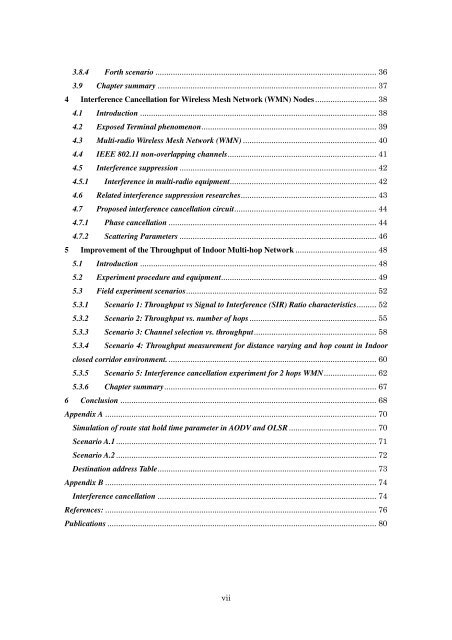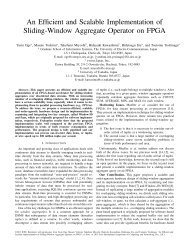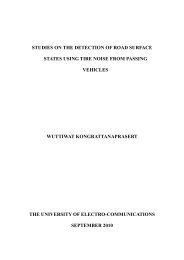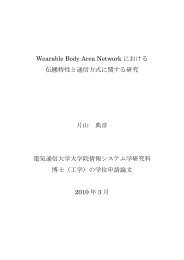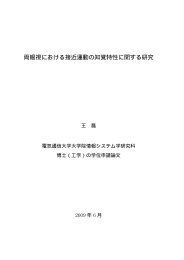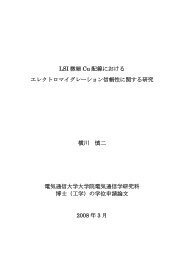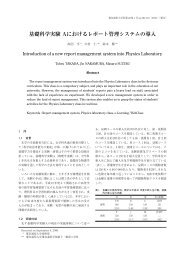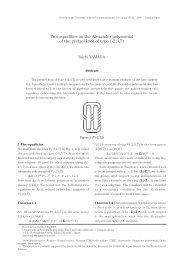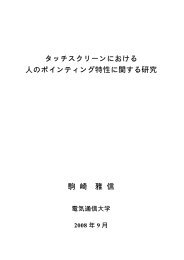a study on the spectrum efficient multi-hop wireless network
a study on the spectrum efficient multi-hop wireless network
a study on the spectrum efficient multi-hop wireless network
Create successful ePaper yourself
Turn your PDF publications into a flip-book with our unique Google optimized e-Paper software.
3.8.4 Forth scenario ..................................................................................................... 36<br />
3.9 Chapter summary .................................................................................................... 37<br />
4 Interference Cancellati<strong>on</strong> for Wireless Mesh Network (WMN) Nodes............................ 38<br />
4.1 Introducti<strong>on</strong> ............................................................................................................ 38<br />
4.2 Exposed Terminal phenomen<strong>on</strong>................................................................................ 39<br />
4.3 Multi-radio Wireless Mesh Network (WMN) ............................................................. 40<br />
4.4 IEEE 802.11 n<strong>on</strong>-overlapping channels.................................................................... 41<br />
4.5 Interference suppressi<strong>on</strong> .......................................................................................... 42<br />
4.5.1 Interference in <strong>multi</strong>-radio equipment................................................................... 42<br />
4.6 Related interference suppressi<strong>on</strong> researches.............................................................. 43<br />
4.7 Proposed interference cancellati<strong>on</strong> circuit................................................................. 44<br />
4.7.1 Phase cancellati<strong>on</strong> ............................................................................................... 44<br />
4.7.2 Scattering Parameters .......................................................................................... 46<br />
5 Improvement of <strong>the</strong> Throughput of Indoor Multi-<strong>hop</strong> Network ..................................... 48<br />
5.1 Introducti<strong>on</strong> ............................................................................................................ 48<br />
5.2 Experiment procedure and equipment....................................................................... 49<br />
5.3 Field experiment scenarios....................................................................................... 52<br />
5.3.1 Scenario 1: Throughput vs Signal to Interference (SIR) Ratio characteristics......... 52<br />
5.3.2 Scenario 2: Throughput vs. number of <strong>hop</strong>s.......................................................... 55<br />
5.3.3 Scenario 3: Channel selecti<strong>on</strong> vs. throughput........................................................ 58<br />
5.3.4 Scenario 4: Throughput measurement for distance varying and <strong>hop</strong> count in Indoor<br />
closed corridor envir<strong>on</strong>ment. ............................................................................................... 60<br />
5.3.5 Scenario 5: Interference cancellati<strong>on</strong> experiment for 2 <strong>hop</strong>s WMN........................ 62<br />
5.3.6 Chapter summary................................................................................................. 67<br />
6 C<strong>on</strong>clusi<strong>on</strong> ..................................................................................................................... 68<br />
Appendix A ............................................................................................................................ 70<br />
Simulati<strong>on</strong> of route stat hold time parameter in AODV and OLSR ........................................ 70<br />
Scenario A.1....................................................................................................................... 71<br />
Scenario A.2....................................................................................................................... 72<br />
Destinati<strong>on</strong> address Table.................................................................................................... 73<br />
Appendix B ............................................................................................................................ 74<br />
Interference cancellati<strong>on</strong> .................................................................................................... 74<br />
References: ............................................................................................................................ 76<br />
Publicati<strong>on</strong>s ........................................................................................................................... 80<br />
vii


